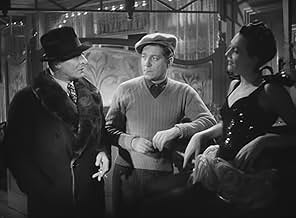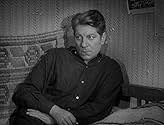IMDb-BEWERTUNG
7,7/10
8709
IHRE BEWERTUNG
Füge eine Handlung in deiner Sprache hinzuAfter committing a murder, a man locks himself in his apartment and recollects the events that led him to the killing.After committing a murder, a man locks himself in his apartment and recollects the events that led him to the killing.After committing a murder, a man locks himself in his apartment and recollects the events that led him to the killing.
- Regie
- Drehbuch
- Hauptbesetzung
- Auszeichnungen
- 1 Nominierung insgesamt
René Génin
- Le concierge
- (as Genin)
Arthur Devère
- Mr. Gerbois
- (as Arthur Devere)
René Bergeron
- Le patron du café
- (as Bergeron)
Marcel Pérès
- Paulo
- (as Peres)
Annie Cariel
- Une locataire
- (Nicht genannt)
Georges Douking
- L'aveugle
- (Nicht genannt)
Georges Gosset
- Un agent
- (Nicht genannt)
Empfohlene Bewertungen
sentimental, far to be great, almost common. but seductive under the science of Carne to give delicate nuances to flash backs, to transform scenes in little gems. and, in same measure, the art of Prevert to transform each detail in a precise piece of puzzle. a film about love and innocence. about a kind of Mephisto - remarkable performance of Berry - and delicate lights of role in Jacqueline Laurent performance. but, in many aspects, a film of Arletty and Jean Gabin. not a surprise. the names of director and scriptwriter are basic guarantees for a remarkable work. but, after so many years, like many other films," Le jour se leve" has more seductive sparkles and great profound value.
French cinema at its best. Ideas of freedom, entrapment, isolation and realism wound into a great film which is carried by Gabin from the opening scene of the murder, through flashbacks he has remembered to the amazingly brutal final shot. Gabin and Laurent in the factory near the beginning of the movie is poetic realism at its most involving.
A fantastic film, which plays with the emotions of the spectator while stunningly portraying the feelings of a pent-up man whose end echoes his pent-up life in the city. The film is beautifully shot in black and white and is a perfect example of French realism, with a modernist time disorientation tossed in for good measure. I found the performances by Jean Gabin and a showgirl with whom he gets involved (played by Arletty)to be strong, portrayed with a kind of hopeless, clutching pathos. Worth it simply for the beautifully constructed final shot.
There is something so lyrical about the tale of the doomed François portrayed by the great Jean Gabin that even in its hardest luck moments you feel you are watching poetry in motion.
In addition, Le Jour se Leve is a character study with all the contradictions that tend to go with pained souls like François' - except that there is a further depth that renders the film quite universal, a depth made of little moments in human relationships and the flaws that gently emerge but only renders the humans involved more endearing.
Still, all that glitters is not gold: the apparently pure Françoise has actually been bedded by M. Valentin (Berry); and the police are more interested in getting their man than in saving him.
The direction is precise and inspired, resorting to the then much used flashback technique but never allowing it to dominate the film.
The photography - well, it is gorgeous and it gives the film its expressionistic ambiance. Finally, Gabin - one of the greatest actors ever in one of his greatest roles. Need one say more?
The ending can be predicted from the moment François kills a visitor in his apartment but that aside it is a film full of cinematographic treasures, acting to gape at, and a quality of direction that is seldom seen these days. A must see for anyone who cares about movies.
In addition, Le Jour se Leve is a character study with all the contradictions that tend to go with pained souls like François' - except that there is a further depth that renders the film quite universal, a depth made of little moments in human relationships and the flaws that gently emerge but only renders the humans involved more endearing.
Still, all that glitters is not gold: the apparently pure Françoise has actually been bedded by M. Valentin (Berry); and the police are more interested in getting their man than in saving him.
The direction is precise and inspired, resorting to the then much used flashback technique but never allowing it to dominate the film.
The photography - well, it is gorgeous and it gives the film its expressionistic ambiance. Finally, Gabin - one of the greatest actors ever in one of his greatest roles. Need one say more?
The ending can be predicted from the moment François kills a visitor in his apartment but that aside it is a film full of cinematographic treasures, acting to gape at, and a quality of direction that is seldom seen these days. A must see for anyone who cares about movies.
Carne and Prevert on a roll; hot on the heels of 'Quai des Brumes' comes this, next up will be Les Visiteurs du Soir' and THAT will be followed by 'Les Enfants du Paradis'. Get out of that, John Ford/Dudley Nichols. Where do you start with something like this, someone send a Runner for a new set of superlatives. Start with the heavy? Jules Berry, they don't come any oilier, he'd already scored in a previous Prevert script, 'Le Crime du Monsieur Lange' with Renoir on bullhorn and he used this as a warm-up for his Satan in 'Visiteurs'. Arletty? Garance-in-Waiting, 'Hotel du Nord' behind her, 'Visiteurs/Enfants' to follow. Gabin? What can I say. Even Nat Cole didn't have a trio like this. To quote the title of an earlier (1935) Gabin vehicle this was truly La Belle Equipe. How Hollywood could cast Hank Fonda in the Gabin role is beyond me. Hank, 'aw shucks' Fonda, niceness personified as decent but RUGGED Gabin? Come on, already. Vincent Price plays Jules Berry? Get real! Sandy Trauner's brilliant apartment building sets the tone here from frame #1. What an opening, Jules Berry exiting Gabin's room and running out of breath. Crowd assembling. Nowhere-To-Go Gabin holed up in his 10 by 6 reminiscing in Gitane time. Never had a chance, life's a bitch and then you die. Basically that's all there is to it. But, as someone once said, it's the way you tell them. Brilliant in spades.
Wusstest du schon
- WissenswertesWhile not the first film to use dissolves to represent flashbacks, it was considered too new a method in the language of cinema that its producers' insisted on pre-title cards to avoid any confusion.
- Zitate
M. Valentin: You're the type women fall in love with . . . I'm the type that interests them.
- VerbindungenFeatured in Un compositeur pour le cinéma: Maurice Jaubert (1985)
Top-Auswahl
Melde dich zum Bewerten an und greife auf die Watchlist für personalisierte Empfehlungen zu.
- How long is Daybreak?Powered by Alexa
Details
Box Office
- Bruttoertrag in den USA und Kanada
- 35.321 $
- Eröffnungswochenende in den USA und in Kanada
- 11.864 $
- 16. Nov. 2014
- Weltweiter Bruttoertrag
- 35.321 $
- Laufzeit
- 1 Std. 26 Min.(86 min)
- Farbe
- Seitenverhältnis
- 1.37 : 1
Zu dieser Seite beitragen
Bearbeitung vorschlagen oder fehlenden Inhalt hinzufügen


































